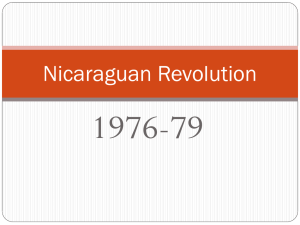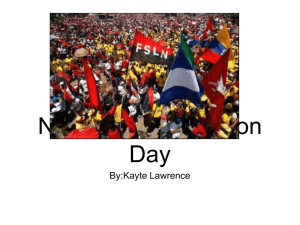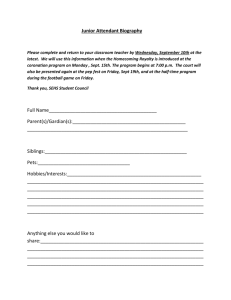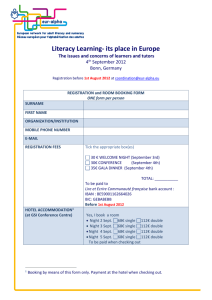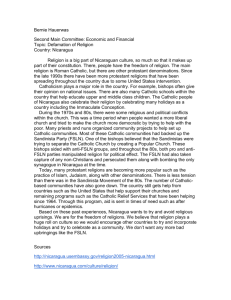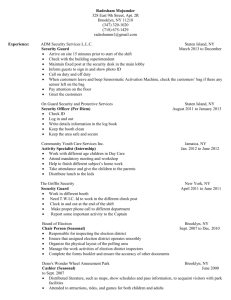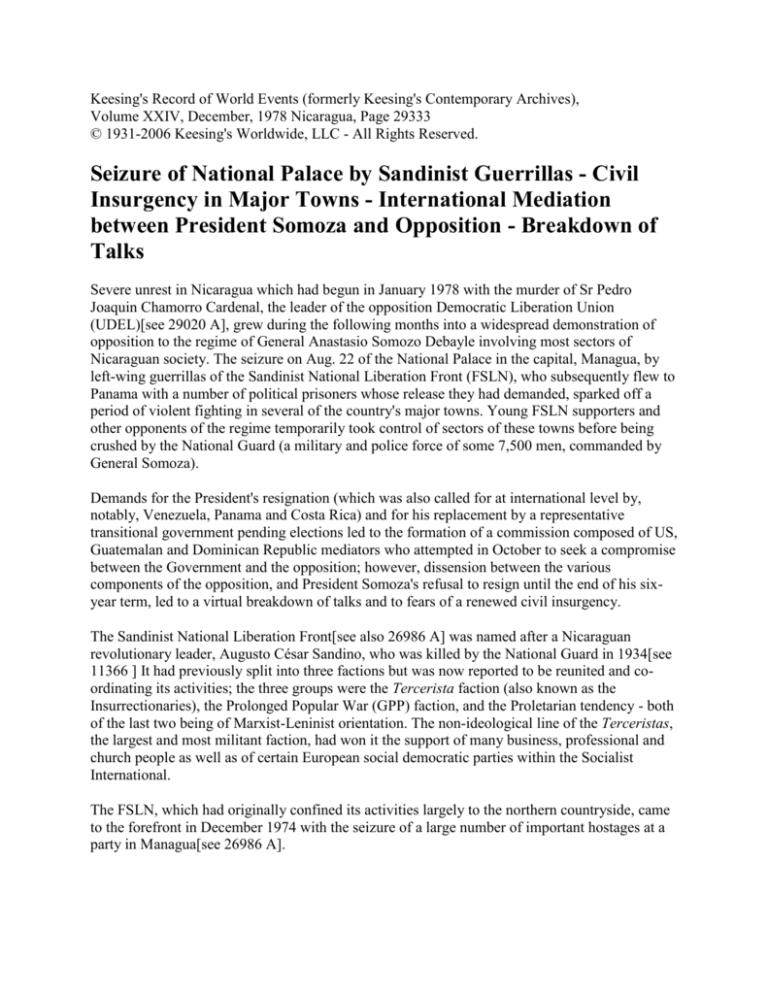
Keesing's Record of World Events (formerly Keesing's Contemporary Archives),
Volume XXIV, December, 1978 Nicaragua, Page 29333
© 1931-2006 Keesing's Worldwide, LLC - All Rights Reserved.
Seizure of National Palace by Sandinist Guerrillas - Civil
Insurgency in Major Towns - International Mediation
between President Somoza and Opposition - Breakdown of
Talks
Severe unrest in Nicaragua which had begun in January 1978 with the murder of Sr Pedro
Joaquin Chamorro Cardenal, the leader of the opposition Democratic Liberation Union
(UDEL)[see 29020 A], grew during the following months into a widespread demonstration of
opposition to the regime of General Anastasio Somozo Debayle involving most sectors of
Nicaraguan society. The seizure on Aug. 22 of the National Palace in the capital, Managua, by
left-wing guerrillas of the Sandinist National Liberation Front (FSLN), who subsequently flew to
Panama with a number of political prisoners whose release they had demanded, sparked off a
period of violent fighting in several of the country's major towns. Young FSLN supporters and
other opponents of the regime temporarily took control of sectors of these towns before being
crushed by the National Guard (a military and police force of some 7,500 men, commanded by
General Somoza).
Demands for the President's resignation (which was also called for at international level by,
notably, Venezuela, Panama and Costa Rica) and for his replacement by a representative
transitional government pending elections led to the formation of a commission composed of US,
Guatemalan and Dominican Republic mediators who attempted in October to seek a compromise
between the Government and the opposition; however, dissension between the various
components of the opposition, and President Somoza's refusal to resign until the end of his sixyear term, led to a virtual breakdown of talks and to fears of a renewed civil insurgency.
The Sandinist National Liberation Front[see also 26986 A] was named after a Nicaraguan
revolutionary leader, Augusto César Sandino, who was killed by the National Guard in 1934[see
11366 ] It had previously split into three factions but was now reported to be reunited and coordinating its activities; the three groups were the Tercerista faction (also known as the
Insurrectionaries), the Prolonged Popular War (GPP) faction, and the Proletarian tendency - both
of the last two being of Marxist-Leninist orientation. The non-ideological line of the Terceristas,
the largest and most militant faction, had won it the support of many business, professional and
church people as well as of certain European social democratic parties within the Socialist
International.
The FSLN, which had originally confined its activities largely to the northern countryside, came
to the forefront in December 1974 with the seizure of a large number of important hostages at a
party in Managua[see 26986 A].
From April 1978 onwards Managua and the country's major towns were gripped by a student
strike which closed schools and colleges in support of improved treatment for political prisoners
and which developed into a general anti-government protest, resulting in demonstrations, hunger
strikes and a strike of hospital and municipal employees which commenced at the end of June. A
number of people were killed and many wounded in clashes with the National Guard during this
period. On May 24, crowds of demonstrators took to the streets in Esteli and burned shops and
cars belonging to Cuban exiles who supported the Government, and on May 25 the National
Guard was placed in a state of alert after clashes with the FSLN in several areas. The
Government closed down five Managua radio stations on May 24.
On July 19 a 24-hour general strike—the second in 1978[see 29020 A]— was called by the trade
unions and the opposition in protest at the allegedly brutal handling of the latest series of antigovernment demonstrations which had begun on July 9 in Jinotepe (where five students were
killed) and subsequently spread to Masaya and to San Marcos (between Managua and Jinotepe),
a total of 26 people being reported killed during these disturbances.
The general strike was reported to have been 75 per cent effective in Managua and the major
towns, and while it was in progress Managua was the scene of an incident in which FSLN
guerrillas launched rockets from the roof of the Intercontinental Hotel (in the centre) onto the
nearby National Guard training school and the fortified presidential compound, where the
Cabinet was in session. One member of the National Guard was killed and three injured, and two
people were arrested after the attack. Fighting was also reported along the Costa Rican border
between guerrillas and the National Guard.
The opposition had in July, prior to the strike, grouped itself into the Broad Opposition Front
(FAO) which was made up of the UDEL, now led by Sr Rafael Cordova Rivas; (ii) the
Nicaraguan Democratic Movement (MDN - formed in April); (iii) the widely supported Group
of 12, which was linked with the FSLN and comprised businessmen, academics, professional
people and priests who returned from Costa Rica on July 5, where they had lived in exile since
the FSLN offensive of October 1977[see 28802 A], which they had openly supported; and (iv)
various small individual parties and the trade unions.
In a statement issued on Aug. 3 the Managua presbyterial council led by the Archbishop of
Managua, Mgr Miguel Obando y Bravo, called for the resignation of President Somoza and the
formation of a government of national unity, as well as political freedoms, the reorganization of
the National Guard, and an end to the prevailing wave of repression by the establishment of a
new economic and social order. Support for the council's statement was expressed by the FAO
on Aug. 7.
Mgr Obando y Bravo was a member of the seven-man commission appointed by President
Somoza in April to investigate the murder of the UDEL leader, Sr Chamorro Cardenal[see 29020
A and above], whose second cousin, Sr Pedro José Chamorro, was later also assassinated in
May. The Government meanwhile sought the extradition from the USA of Sr Pedro Manuel
Ramos, a Cuban exile, in connexion with the murder of the UDEL leader.
It was announced on Aug. 11 that President Somoza had dismissed 30 of the 35 commanding
officers of the National Guard in an apparent attempt to avoid new confrontations between the
military and civilians. One of those dismissed was the chief of the Managua police, who was
accused of excessive use of force.
It had been reported on May 16 that the USA, which at the beginning of February 1978 had
suspended all military aid to Nicaragua[see 29020 A], was releasing $12,000,000 in non-military
aid which, like the military aid, had been frozen on human rights grounds. The release followed
activity by a pro-Nicaragua lobby in the US Congress led by Representative Charles Wilson, a
Texas Democrat.
About 25 Sandinist guerrillas on Aug. 22 occupied the National Palace in Managua—which
housed inter alia the National Congress and the Ministries of the Interior and of Finance—and
took hostage over 1,000 people who were in the building at the time. Most of these either
escaped or were later allowed to go free, leaving about 70 hostages including members of
Congress; the Deputy Speaker of the Chamber of Deputies, Sr Luis Pallais Debayle (who was
also President Somoza's cousin); Sr José Somoza Abrego (the President's nephew); the Minister
of the Interior (Sr José Antônio Mora Rostran); and a number of journalists. The guerrillas
demanded the release of about 78 Sandinist prisoners and aircraft to fly them out of the country;
a general amnesty for political prisoners; a ransom of $10,000,000; the broadcasting of a
statement denouncing the Government; and a 50 per cent pay increase for hospital workers who
had been on strike for a month.
After a 48-hour siege the guerrillas-whose demands had been largely met by the Government-left
Nicaragua for Panama on Aug. 24 in two aircraft provided by the Panamanian and Venezuelan
Governments, accompanied by several of the hostages and by 59 political prisoners who had
been freed. Two Nicaraguan bishops and the Archbishop of Managua, as well as the Panamanian
and Costa Rican ambassadors, flew with them to guarantee their safe passage.
The guerrillas, belonging to the self-styled "Rigoberto López Perez commando" (after the
Sandinist who assassinated President Somoza's father in León in 1956A) and led by Sr Eden
Pastora Gomez ("Commander Zero"), burst into the National Palace disguised in National Guard
uniforms and killed about six guards, while a dozen people were reported injured. The guerrillas
then issued their demands through the Archbishop of Managua, who entered the building with
other church representatives to act as mediator, this task being subsequently assumed by the
Panamanian and Costa Rican ambassadors. The guerrillas on Aug. 23 agreed to a government
demand that women, children and the wounded should be released and the dead evacuated before
negotiations commenced, and also agreed to postpone carrying out their threat to kill the first of
the hostages until the Government had had time to consider their demands. Also on the same day
President Somoza declared a state of emergency, closed airports and sealed the border with
Costa Rica.
In the evening of Aug. 23 the guerrillas' statement calling for a "truly democratic and popular
government" to replace the "Somoza dynasty" was broadcast on radio and television and the
Government subsequently agreed to pay a reduced ransom of $500,000, to release political
prisoners, and to guarantee the guerrillas and the prisoners a safe passage out of the country. The
guerrillas and five of their hostages were driven to the airport, the remaining hostages having
been released before the guerrillas left the building; crowds of people were reported to have
gathered in the streets and along the road to the airport in support of the FSLN, some of them
carrying the black and red Sandinist colours. The freed political prisoners were waiting at the
airport and were flown together with the guerrillas to Panama in a Panamanian commercial
aircraft and a Venezuelan Hercules transport plane; on arrival in Panama they were granted
political exile status, which meant that they were forbidden to make political statements or carry
out political activities while on Panamanian territory.
Sr Pastora Gomez (42), a Nicaraguan who had recently assumed Costa Rican citizenship, had
been involved in guerrilla activities against the Nicaraguan Government since the 1960s and was
now a leader of the Tercerista faction of the FSLN.
After the departure of the guerrillas for Panama, President Somoza told a press conference in
Managua on Aug. 24 that he hoped the people would understand his reluctance to use force
against the guerrillas in the recent incident, which he said was backed by Cuba; he claimed that
the FSLN had been virtually eliminated, especially in the north of Nicaragua, and that those who
had attacked the palace had been newcomers.
In Venezuela, President Perez on Aug. 24 called for a "cordial intervention" by the Organization
of American States (OAS) to "seek a process of democratization and to avert further pointless
bloodshed", adding that no one, no matter how powerful, had the right to "sacrifice the life of his
nation".
On Aug. 24 the Broad Opposition Front and the trade unions called a general strike to try to
bring down the Somoza Government. The strike began the following day, at first lacking wide
support in Managua but gaining momentum until, by the end of the month, most shops and
businesses were closed, especially in the provinces. The strike was also supported by the private
sector through the Federation of Nicaraguan Chambers of Commerce (which President Somoza
banned on Aug. 28) and the Nicaraguan Development Institute (INDE-which was also banned on
Sept. 3). As the strike took effect clashes occurred between anti-government demonstrators and
the National Guard in a number of towns including Managua (where four people were killed),
Masaya, Jinotepe (where one student was killed), Eseli, Somoto (near the Honduran border) and
Diriamba (near Managua) - the worst incidents, however, taking place in Matagalpa (situated
some 75 miles north-east of the capital), where about 500 teenage boys and girls, using light
arms and with the apparent support of the rest of the town's inhabitants, gained control of a large
sector of the town on Aug. 28-Sept. 1 after heavy clashes with the National Guard.
The National Guard, controlled in Matagalpa by President Somoza's son, Major Anastasio
Somoza Portocarrero (26), strafed the occupied sector on Aug. 30 from military aircraft;
communications were cut off and attempts by the Archbishop of Managua to negotiate a truce
between the two sides were largely unsuccessful. During a temporary ceasefire on Aug. 31
hundreds of inhabitants fled the town, and on Aug. 31-Sept. 1 the National Guard broke down
barricades and regained control of the occupied sector, many of the young insurgents fleeing into
the surrounding hills. The Nicaraguan Red Cross sent in ambulances to collect the wounded,
whose numbers they estimated at between 100 and 200; some 25 to 50 civilians were also
reported to have been killed. During the next few days the National Guard carried out house-tohouse searches and arrested young people in the town.
A spokesman for the US State Department on Aug. 30 expressed the concern of the
Administration at the escalation of violence in Nicaragua and at the "human suffering
engendered by this violence"; it remained the hope of the United States, he added, that Nicaragua
would arrive at a democratic and peaceful solution to the problems "which have seriously
divided its people".
With the general strike continuing into September, the National Guard began to carry out arrests
of strike supporters. According to a National Guard communiqué (on Sept. 3), 200 "agitators"
had been detained in Managua since the previous day and 500 troops were patrolling the city to
protect those who reopened their shops and businesses from "anti-government forces". In the
evening of Sept. 3 General Napoleón Suazo, the Secretary-General of the Armed Forces, stated
on television that the National Guard would thwart the "internal and external" forces of
"communists" who were trying to overthrow the Government.
Although opposition reports estimated that some 600 people had been arrested -including seven
strike leaders who were lawyers, businessmen and politicians - President Somoza said on Sept. 5
that only 130 people remained in custody, charged with throwing bombs and intimidating nonstrikers. He stated his intention to sit out the strike and described President Pérez of Venezuela as
an "impudent interventionist" in calling for meetings of the OAS and of the UN security Council
to consider the Nicaraguan security situation. He called on all OAS member-states "not to allow
themselves to be used for these manoeuvres" and said that he would hold Venezuela responsible
for any bloodbath caused by President Perez's incitement to the opposition.
However, a Venezuelan Foreign Ministry spokesman replied on Sept. 5 that Venezuela would
stand by its decision to "bring before international organizations the crisis which is being
experienced by our brother people in Nicaragua". On the same day President Carazo Odio of
Costa Rica telephoned the Presidents of Guatemala, Honduras and El Salvador to express his
concern about the continuing violence in Nicaragua, and subsequently announced that he had
sent his Foreign Minister, Sr Rafael Angel Calderón, to these three countries to "seek a peace
formula for Nicaragua", disclosing that he had informed President Somoza of the move.
The US Administration, which had on Sept. 5 expressed further concern "at the loss of human
life in Nicaragua and at the information concerning numerous arrests of opposition leaders",
welcomed the Costa Rican initiative on Sept. 7 and said that it preferred mediation efforts to be
carried out by Central American states rather than by the OAS. Venezuela subsequently, on Sept.
11, postponed its plans to submit the Nicaraguan issue to the OAS, in order to allow Costa Rica
time to pursue its efforts.
Meanwhile, on Aug. 28, what was reported to be an attempted coup by conservative members of
the National Guard who were angered that President Somoza had met the demands of the
guerrillas who stormed the National Palace[see above] was put down without bloodshed. A
statement from the National Guard said that "elements of the Army and civilians" (who were
reported by other sources to number about 85, including 12 senior officers) had been arrested for
plotting to overthrow the Government, while a National Guard spokesman later disclosed that the
attempt had been led by Lt.-Colonel Bernardino Larios, a Brazilian- trained engineer, and by Lt.Colonel Eduardo Montalba, commander of the northern Ocotal region; it was stated that both
men were under arrest.
In an air crash on Sept. 8 believed to have been caused by sabotage, the chief of operations of the
National Guard, General José Ivan Allegrett, and three mercenary counter-insurgency experts
(two US and one Vietnamese) were killed while flying south of Lake Nicaragua (near the Costa
Rican border).
After a small group of Sandinists had entered a Managua radio station on Sept. 7 and had
broadcast a call for insurrection against the Somoza regime, heavy fighting broke out on Sept. 9
in Masaya, León, Esteli, Chinandega and Diriamba between the National Guard and Sandinist
supporters, and continued in some of these towns for more than a week, causing heavy casualties
and serious damage to property. With the general strike in its third week, President Somoza directing operations from the presidential compound in the centre of Managua - on Sept. 11
declared a state of siege and martial law in Esteli and Masaya, and this was extended throughout
the whole of the country on Sept. 13. The National Guard moved against the insurgents with
tanks, armoured cars and heavy weaponry and used aircraft and helicopters to bombard and
strafe rebel positions in the towns.
There had also been guerrilla attacks in Managua itself on Sept. 9 when Sandinists carried out
assaults on National Guard posts on the city's outskirts. The National Guard, affirming that
rebels from Matagalpa were infiltrating into the capital, set up barricades on the northern route
out of the city.
In Masaya heavy fighting took place in the town's centre on Sept. 11; helicopter gunships strafed
the streets and refugees reported "dozens" dead in the fighting. The Red Cross was barred from
entering the town from Sept. 11 onwards, and the town was without electricity or water and was
reported to be in ruins.
Although the National Guard claimed shortly afterwards to have regained control of León and
Masaya, fighting continued over the next few days in all five towns. At a press conference on
Sept. 12 President Somoza forecast that within a week his troops would have crushed the
insurrection, which he described as "the most bloody offensive against the constitutional
Government that Nicaragua has experienced for 50 years", and he gave National Guard losses in
the fighting so far as 30 dead and 60 wounded.
On Sept. 12–13 the National Guard won back Masaya, and early on Sept. 15 a final airborne
offensive was launched to recapture León, the National Guard firing rockets into the town before
sending in troops to carry out house-to-house searches. By Sept. 16 resistance had been crushed
in León and the Red Cross was allowed to enter the town to evacuate the wounded and dispose
of the dead; although full press censorship had been imposed on Sept. 15, it was reported that the
centre of the town had been completely gutted. Chinandega fell to the National Guard on Sept.
18, but Esteli (whose centre was reported to be in flames) was not recaptured until Sept. 21,
although a National Guard communique of Sept. 19 had already announced that the insurgents
had been overcome.
During the siege of the towns the FSLN also temporarily seized the town of Penas Blancas on
the Costa Rican border but was driven off by the National Guard on Sept. 17.
According to Red Cross figures quoted in Latin America Political Report (issue of Oct. 6, 1978)
5,000 people had died in the fighting, up to 10,000 had been injured and 25,000 had been
rendered homeless; some 6,000 refugees had fled to Honduras and 7,000 to Costa Rica.
In the meantime, the conflict threatened to extend outside Nicaragua's borders when the Costa
Rican Government on Sept. 12 accused Nicaragua of bombarding its territory near the frontier
and also of following rebels into Costa Rican territory during "hot pursuit" operations - the
Nicaraguans for their part claiming that three guerrilla attacks had been launched from Costa
Rica. On Sept. 14 Venezuela sent four jet bombers to Costa Rica (which had no armed forcesA)
on a "goodwill visit", and on the following day signed a co-operation and mutual aid agreement
with Costa Rica. The Panamanian Government also sent four military helicopters, and in both
Venezuela and Panama volunteers began to form a force to support the FSLN. In the light of
these and associated actions, the Nicaraguan Government on Sept. 16 announced the recall of its
ambassadors to Costa Rica, Panama and Venezuela, and on Sept. 17 it accused the Venezuelans
of having strafed its territory from their aircraft earlier that day in support of a guerrilla column
which was moving into Nicaragua from Costa Rica. Nicaragua's ambassador to Colombia was
later, on Oct. 25, also reported to have been withdrawn following Colombia's offer in September
of medical supplies and military equipment to the insurgents.
The Permanent Council of the OAS on Sept. 18 accepted a Venezuelan proposal to convene a
meeting of Foreign Ministers to consider the "grave incidents" occurring in Central America, the
proposal being accepted by 23 votes to one (Paraguay), with one abstention (Trinidad and
Tobago). The meeting accordingly took place in Washington on Sept. 21–23 (although most
Foreign Ministers sent deputies to represent them), but the 25 members adopted only a resolution
agreeing to abstain from any direct intervention in Nicaragua, to provide purely humanitarian
aid, and to send an investigation team to look into the border violations reported by Nicaragua
and Costa Rica. The final paragraph of the resolution noted Nicaragua's willingness to accept the
"friendly co-operation and/or conciliatory efforts which several member states of the
organization may offer towards establishing the conditions necessary for a peaceful settlement
without delay".
With the apparent defeat of the insurgents by the National Guard, shops, factories and businesses
reopened on Sept. 25, signalling the end of the general strike which had continued for almost five
weeks. Shortly afterwards, President Somoza declared an amnesty for political prisoners with the
exception of those detained for certain terrorist activities, it being estimated that about 350
people would be eligible for release, including the seven strike leaders who had been arrested
early in the month.
A six-man team of the (OAS) Inter-American Commission on Human Rights arrived in Managua
on Oct. 3 to investigate the charges made against the Somoza regime. A meeting took place with
President Somoza at which he accepted the commission's two conditions, namely that the press
and news media should announce that the commission was convening hearings and (ii) that the
safety of those testifying should be guaranteed.
The US State Department had in a statement issued on Sept. 20 expressed deep concern at
mounting reports of atrocities committed by the National Guard against unarmed civilians during
and after the fighting and had urged President Somoza to "discipline and control" his forces, as
well as calling for an urgent investigation into human rights in Nicaragua to be carried out by the
Inter-American Commission on Human Rights. The statement had been prompted by a report in
the Washington Post of Sept. 20 which said that, according to residents of León, at least 14
young men had been executed by the National Guard on Sept. 15 despite their pleas for mercy.
However, reports of atrocities had been denied by President Somoza.
The Nicaraguan alternate permanent representative at the United Nations, Sr Enrique Paguaga,
had handed in his resignation on Sept. 28 and denounced his Government for "genocide";
maintaining that the insurgency was backed by the Nicaraguan people, he claimed that the
National Guard had fired on Red Cross ambulances, killed women and children and recruited
mercenaries, and he also denounced murders, kidnappings and torture in his country.
President Perez of Venezuela and President Turbay Ayala of Colombia on Sept. 27 sent a joint
letter to Dr Indalecio Lievano Aguirre the President of the UN General Assembly, asking for
immediate UN action to stop the "genocide" in Nicaragua.
President Somoza said at a press conference on Oct. 4 that he had decided to double the size of
the National Guard to 15,000 men and that the defence and security budget was to be increased
from 10 per cent to 20 per cent of the national budget.
Sr Ernesto Cardenal, a member of the FSLN (which had recently begun a diplomatic offensive in
Europe on Sept. 12) as well as a poet and priest, confirmed in Lisbon on Oct. 2 that the FAO had
appointed a triumvirate to govern Nicaragua in the event of the resignation of President Somoza.
Its three members were Sr Sergio Ramírez Mercado (34) of the Group of 12, Sr Cordova Rivas
(55) of the UDEL and Sr Alfonso Robelo Callejas (38) of the MDN.
The Nicaraguan Government meanwhile announced on Sept. 25 that it would accept an offer by
the United States to mediate between President Somoza and the opposition "for the purpose of
helping in the search for peaceful solutions to the present situation in Nicaragua with the
participation of interested political opposition groups". The announcement followed meetings in
the previous three days between President Somoza and Mr William Jorden, President Carter's
special envoy, who also visited other Central American capitals. Mr Jorden had meetings in
Nicaragua with representatives of political, church and business organizations including the FAO
but had no contact with the FSLN itself.
On Sept. 29 the President announced on television that he had also agreed to accept the (OASsponsored) mediation of Guatemala and the Dominican Republic together with the United States.
Accordingly, a mediation commission consisting of Mr William G. Bowdler (a former US
ambassador to Guatemala, El Salvador and South Africa), Rear-Admiral Ramón Emilio Jiménez
Reyes Hiso (the Foreign Minister of the Dominican Republic) and Sr Alfredo Obiols Gomez (a
former Guatemalan Deputy Foreign Minister) held a meeting in Guatemala City on Oct. 5 before
arriving in Nicaragua on Oct. 6, where it immediately began meetings with President Somoza
and with representatives of the FAO and of church, business and other organizations. Officials of
the US State Department said on Oct. 3 that the United States' aim was to bring about the
resignation of President Somoza and his Government and to replace it by a transitional
government to prepare Nicaragua for free elections.
The FAO at first stated as a body that it would have nothing to do with the mediation
commission, but it rapidly became evident that the different factions of the front were divided
over this and other basic issues. Although all were committed to bringing down the Somoza
Government, the conservative elements and many businessmen belonging to the MDN feared
that, in this eventuality, the FSLN would take control of Nicaragua and install a radical
government; the FAO position as a body was that the FSLN should be included in any
government established after the resignation of President Somoza.
Despite these differences, the first round of negotiations between the FAO and President Somoza
took place on Oct. 16, but no apparent progress was made. President Somoza continued to insist
on remaining in office until 1981, while the opposition demanded inter alia the dissolution of
Congress, the recognition of the FAO provisional government and the replacement of the
National Guard by a popular army and the removal of General Somoza as its head.
The FAO had previously demanded on Oct. 7 that the President should immediately lift martial
law and press censorship as prior conditions for the commencement of negotiations; however,
President Somoza's office on Oct. 12 announced that martial law and the suspension of
constitutional guarantees would remain in force until April 30, 1979, because Nicaragua
continued to be faced with threats to its internal peace from terrorist organizations and certain
foreign governments. A further statement issued on Oct. 14 announced that the curfew would be
retained in a reduced form in Managua and some of the country's departments. News censorship
was, however, lifted on Oct. 9, whereupon the opposition La Prensa appeared for the first time in
over three weeks.
The Group of 12 (whose members by now numbered only seven) on Oct. 26 withdrew both from
the mediation talks and subsequently also from the FAO on the grounds that the mediation
commission was now trying to force on the opposition a political programme involving the
inclusion of members of the (government) Liberal Party in a future governing formula and that
the US Administration wanted to install a "docile government" to their own liking in Nicaragua;
several of the group's members sought asylum in the Mexican embassy in Managua. Talks
subsequently threatened to collapse completely when the Nicaraguan Workers' Central (CTN) on
Nov. 3 also announced its withdrawal from negotiations, the Socialist Party later following suit.
With the withdrawal of the Group of 12 from the FAO, moreover, links were effectively cut
between the mediation commission and the FSLN and it was feared that new fighting would
break out in Nicaragua.
In an attempt to force the Somoza Government to make concessions, the United States on Nov. 1
succeeded in bringing about the delay of a $20,000,000 loan under the compensatory financing
facility of the International Monetary Fund (IMF). Announcing this decision on Nov. 1, Sr
Roberto Incer Barquero, the president of the Nicaraguan Central Bank, criticized the "flagrant
violation" of the IMF's Articles of Agreement which were "supposed to be free of political
implications", and he said that Nicaragua would now have to take "additional foreign exchange
measures" to meet the country's debts of $900,000,000. Foreign exchange operations were
temporarily halted in Nicaragua on Nov. 3.
Furthermore, President Carter said on Nov. 9 at a press conference in Kansas City that the United
States was now actively negotiating for the formation of a government in Nicaragua which was
"fully supported by the people".
Meanwhile, the Nicaraguan Government on Nov. 6 presented the mediation commission with
liberalization proposals believed to include concessions such as the elaboration of a new
electoral law and a judicial reorganization. On the same day the FAO set a 15-day deadline for
the solution of the political crisis.
One of the leading members of the Liberal Party, Sr Ramiro Granera Padilla (60), died on Nov. 8
after being shot by unidentified assailants the previous day.-Times - Guardian - Daily Telegraph
- Le Monde - BBC Summary of World Broadcasts - Neue Zürcher Zeitung - Economist - Latin
America Political Report - International Herald Tribune - Financial Times)(Prev. rep. 29020
A;28802 A;1974 Standinist Action, 26986 A; US Aid to Nicargua, 29020 A;28762 A;28625 A;)
© 1931- 2008 Keesing's Worldwide, LLC - All Rights Reserved.


